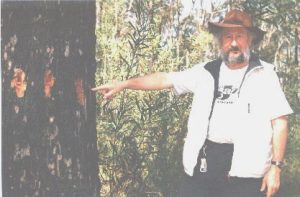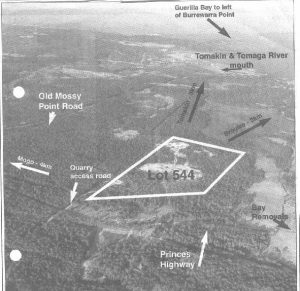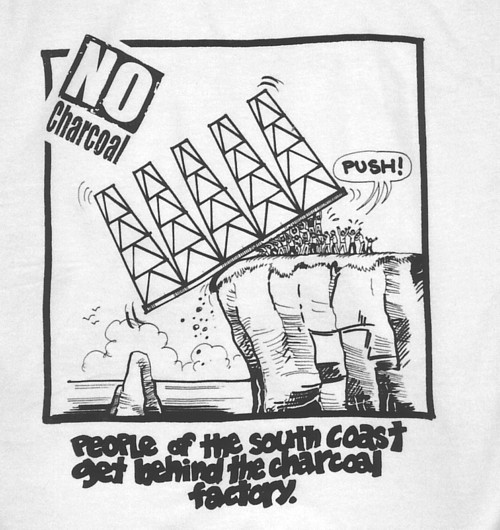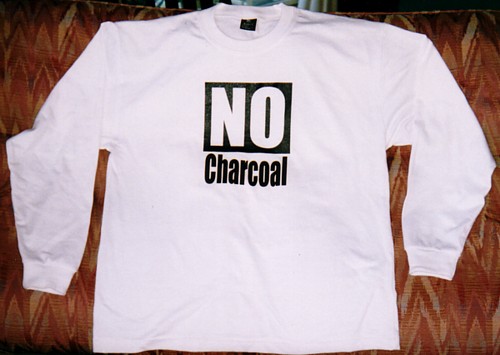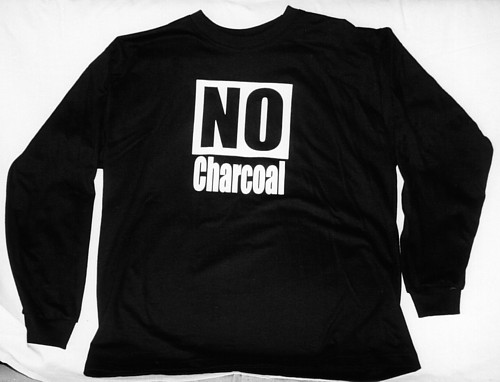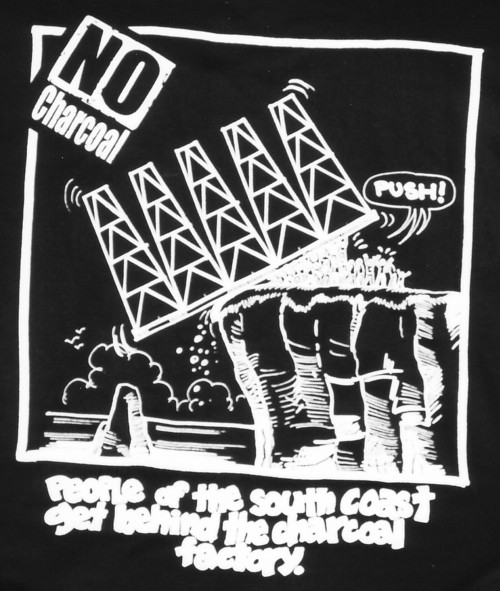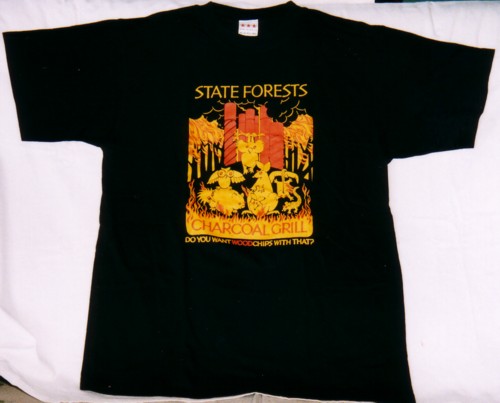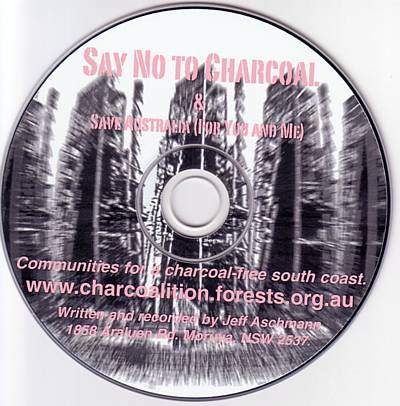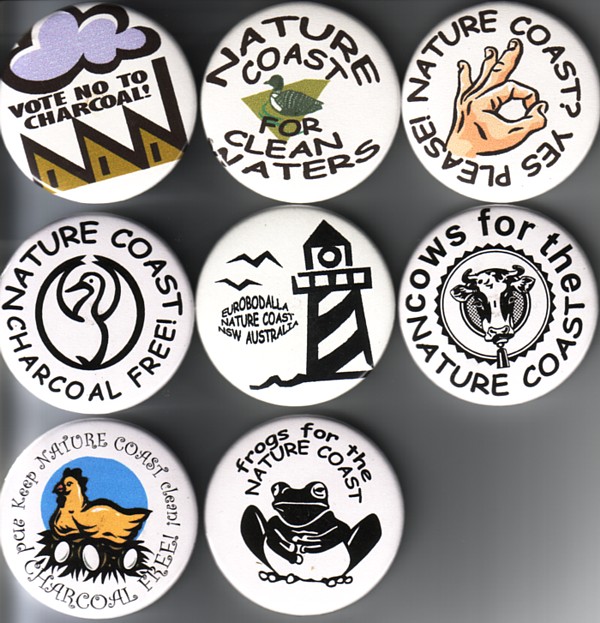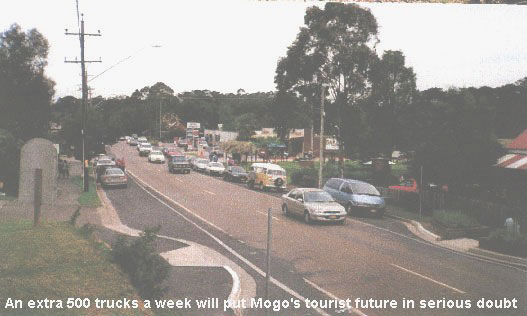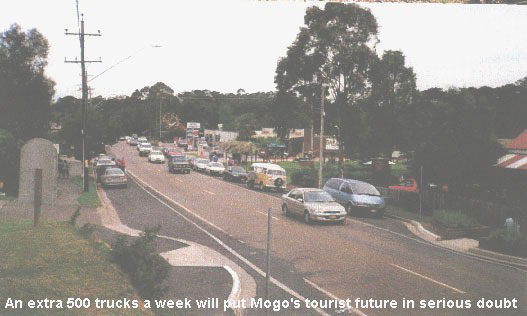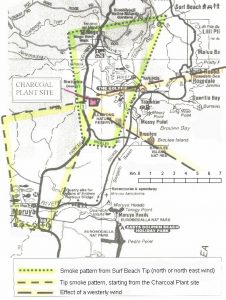CRITICISMS OF THE EIS
Parts of the EIS are not written in a way the general public can understand, especially air emissions
Many readily available sources of information appear to have been ignored
eg —
* statistics relating to the tourism industry – available from Eurobodalla Tourism;
* knowledgeable Council staff
* NRMA report on road safety on the Kings Highway
WOOD SUPPLY
The EIS says that the wood “will be sourced from the unsold salvage quality and pulp residue logs”. (p 2.23) That is “defective” trees can be cut down and if no millable component is found it can all go to the charcoal factory.
The EIS implies that extraction of this quantity of charcoal wood is not sustainable. The Leech report says there should be enough for 20 years, while admitting that FRAMES is imprecise– “longer term issues are not so relevant” (Appendix D – Leech p 9). This is mining the forest of older trees.
Plantation of 8000ha (note Australian Silicon presentation said 20,000ha) in the Murray Darling Basin is supposed to supply wood for charcoal after 20 years (p18.7) but the EIS also says plantations are not expected to be available for 2 or more decades (p 2.25)
Judging from studies by CSIRO Forests the plantation wood will be too young, have insufficient heartwood, and have insufficient tonnage in such a short period.
Appendix B – DUAP letter p 2 Where is the letter from NPWS dated 24 September, 2001 that was supposed to be evidence that NPWS had altered its opinion that the wood source should be included in the EI?.
In Appendix D reference is made to the “forthcoming NSW FA and IFOA”. These should have been made public before the EIS was exhibited.
Why wasn’t the Residue Wood Supply Forecasts document included in Appendix D? The Leech report is inadequate without the document to which it refers.
The Leech document has drawn conclusions without evidence – for instance it assumes BRS acceptance of FRAMES ( Appendix D – Leech p 3)
CH 2 ALTERNATIVES
The EIS says that having the charcoal plant at Lithgow would minimise transport damage to the product. (p 2.5) Alan Townsend, Australian Silicon, said that about 5% of the product from Mogo is likely to be damaged. What tests have been done to see if this percentage is accurate? It appears that it could be much more. Australian Silicon admits tht the most plentiful species, Spotted Gum, produces the most friable charcoal (p 2.20) What percentage would make the supply from Mogo uneconomic?
CH 4 PLANNING
Does the NSW Coastal Policy 1997 apply to the site? If not why not, since it appears to be within 1 km of a tidal estuary? (Ch 4), and the estuary could be affected by contaminated stormwater run-off from the plant site. Also Candlagan Ck, recommended for Significant Protection in the Healthy Rivers Commission Inquiry into Coastal Lakes.
Why weren’t the site’s quarry conditions made public? (p 4.1) NPWS state that “the clearing of Yellow-bellied Glider habitat for the quarry was on the basis of retaining the other vegetation on site (both within the extractive area and the 25 hectare area to the south). Both areas are to be largely cleared in this proposal.” (Appendix B – Attachment 4 – p 4)
CH 5 ISSUE IDENTIFICATION
The community consultation process (p 5.5) was inadequate and questionable. The company failed to attend two major public meetings. The community was told by the company at its public meeting – “Sensible dialogue with people has not been possible until now.”
CH 6 SOCIO-ECONOMIC
The EIS says it is hard to value natural resources but there are plenty of studies/reports they could have used. Instead they assumed, without any real justification, that social costs would be kept to a minimum (p 6.1) and did not estimate what these minimum costs would be.
The proposal does not fit with people’s wishes for the way the area should be developed. The EIS did not mention the huge public opposition (refer to local papers and federal candidates)
The EIS should specify the job structure in the facility. (p 6.8)
To assess the benefits of forest jobs the EIS should state how many are currently employed and in what activities. (p 6.8)
It has not looked at the economics of the facility in the setup, operations and wind down phase. Nor has it looked at the social impacts of wind down.
The EIS says there will be an input to the region of $9-10 m per year (p 18.6). What is the breakdown of these figures? How much of it goes to the government in royalties, taxes, etc
Wage benefits of $1.85m per year to the regional economy are based on gross wages not take home pay, and in any case there is no guarantee that all the transport workers and suppliers will be local. (p 6.7) Note a different figure, $630,000, is given later (p 18.4)
The EIS makes unjustified statements that the facility will not impact on the “Nature Coast” image (promoted by Council at great expense to ratepayers) and is “not expected to have any economic or social cost to the tourism industry”. (p 6.9)
No tourists or non-resident ratepayers were surveyed.
There was no indication of the small scale of the other industries in the vicinity used to justify the proposal. (p 6.9) For example the quarry only operates on demand with a few loads a week typical.
The EIS says the site is not near major tourist areas (p 6.10) but Broulee, Mossy Pt and Tomakin are important tourist areas.
The EIS says these villages will not be affected directly or indirectly (p 6.10). However, emissions will be trapped by inversion layers. In winter fogs regularly extend along the creek lines to the coast.
Residents of the villages predominantly use private vehicles to get to Batemans Bay (mainly) or Moruya. The villages will be indirectly affected by greater truck numbers on the highway.
Traffic impacts were minimised – eg in assessing traffic impacts on Mogo the EIS quoted increased vehicle movements not heavy vehicle movements. (p 6.10) Trucks were counted as cars!
The demographic profile (p 6.3) showed the high proportion of young children and the elderly and the EIS noted the reliance on private vehicles (p 6.4). Young and old will be particularly at risk from the increased number of heavy vehicles.
The impact on land values (p 6.11) is inadequate and there is insufficient justification for the concluding statement. There was no attempt to value land that might be affected, no information sought from Real Estate Agents, landholders (including non-resident ratepayers) were not consulted.
Not enough information is presented on cost-benefits. For instance what is the value of the electricity subsidy to the silicon plant at Lithgow?
Demographics (p 6.3) – it states that 34% of the population were aged over 55 years, but there was no survey done of retirees to ascertain why so many choose to live in this area, and how the introduction of a charcoal plant in their area would affect them.
CH 7 TRAFFIC
The EIS fails to adequately address road safety issues associated with transport. In particular, the Kings Highway, Mogo school, the elderly (particularly at Mogo).
The EIS appears to deliberately use vehicle movements to show traffic impacts (most of the tables in Ch 7). It is the heavy vehicle component that is of most concern.
The impacts of logging trucks on roads other than the Princes Hwy have been ignored, ie Council feeder roads and Kings Hwy. (pp 3.8 and 7.2).
The impacts on the Braidwood to Goulburn Rd and the Northern Road were not mentioned
(p 7.3)
What studies were done on the health, noise and safety impacts of extra trucks in Mogo or homes near the Kings Highway?
The EIS estimates 28 tonne loads for green timber but the loads are likely to be lighter due to difficulties of packing bent limbs. This will mean more truck movements. (p 7.3)
Charcoal loads were estimated at 24 tonnes. (p 7.3) Given the low density of charcoal is this possible? If the density is about 200-300 kg/cubic metre – allowing for airspaces between the lumps – the truck would have to be able to carry up to 120 cu m. More truck movements will be needed.
The density of sawdust is also much less than of wood and again more truck movements will be needed.
The sawdust market may end up being Canberra (P Anderton at public meeting) making truck movements on the Kings Hwy worse.
The RTA appears to be getting ready to allow B-doubles on the Kings Hwy (leaked report) and the EIS implies they could be used to transport timber from the forests.
(p 7.9). What impact will these have on road safety?
The EIS did not properly address the costs to ratepayers and taxpayers of road infrastructure upgrades needed for the project; (p 7.13). For example, costs of bridge upgrades were not mentioned.
How much will it cost State forests in extra road maintenance and bridge upgrades? Will all of this as well as other increased costs to SF be included in the price the company pays for wood?
Traffic patterns could change if harvesting is concentrated in one area. For example the impact could be much greater on Mogo if nearly all the wood trucks are coming from the north.
CH 8 NOISE
Noise at the moment is minimal (p 8.4). The quarry only operates infrequently and never at night. Noise levels will increase significantly. Mitigation measures will not eliminate noise.
The EIS does not look at the impact of noise and vibration on fauna.
Were the noise mitigation measures (p 8.24) actually tested by installing the necessary insulation, etc on similar equipment and monitoring it? Or will the residents be the guinea pigs?
The effects of factory and truck noise in a peaceful rural environment on residents closer to the site and highways has not been addressed.
CH 9 AIR QUALITY
Did any independent body check the data supplied by ASPL and the retort manufacturer? (p 9,2) These were the basis of the calculations.
The tables appear to be deliberately constructed to give misleading impressions. For example emissions in grams per second (Appendix J -Table 1)
For example – 0.24 g/s particulate matter = 864 g/hr = 20.736 kg/day
Weather data came from an exposed coastal position and was used without adaptation to the site to calculate the effect of air emissions. (Appendix J.9)
The site selection process started early in 2001. The company should have set up a meteorological station to get data to correlate with Moruya Airport. There was no attempt at correlation.
The EPA guidelines for EIS preparation say the AUSPLUME model is not suitable for coastal areas. It was used in this EIS. An appropriate model would have given much higher ground level pollutant concentrations according to CSIRO.
The EIS says the 2 door loading system to the retorts will “prevent” (p 3.13) or “minimise”
(p 3.15) air and gas exchange. However, it appears hot gases rising from each retort will fill the chamber and escape next time the outer doors are opened. Loading will happen 15-20 times an hour – total of 5 retorts (p3.13).
A company spokesman said the doors will have to be scraped to clean of tar every couple of months — evidence of waste gases in the chamber. Were these gases included in the emissions modelled? These emissions will not be monitored.
The pyroligneous gas etc is said to be “readily combustible if the moisture content is below 25% of the wood”. (p 3.18) What will be the effect on emissions if moisture content is higher?
What will be the impact on untreated and treated emissions of using mixed species instead of Jarrah? (App J – Table 1)
What will be the results if the groups of timber types are treated at the wrong temperatures? We understand from WA trials that many more toxic chemicals can be produced.
Why wasn’t the new particulate matter standard of PM2.5 used? (Appendix J.3)
Dioxins could be present in emissions.(p S.20 and Kerry Holmes at public meeting). Isn’t this a new source and so illegal? The EIS does not quantify the dioxin production.
Existing levels of particulate matter average about 20-25micrograms/m3. The facility will add about 3 more. ie 12-15% more (Kerry Holmes at public meeting)
A sawdust incinerator is shown. How will emissions be minimised? What emissions will remain and in what quantities?
What will be the cumulative impact of air emissions on top of already high winter levels especially for schools and elderly?
Who will monitor dust and air emissions? Where and how often will they be monitored?
(App J.9).
CH 10 SOIL & HYDROLOGY
More recent studies have shown that the soils are highly dispersable and not highly permeable due to compaction that will be caused by the machinery. (p 10.1) Pollutants and fine sediments will run-off.
Why wasn’t water quality data from Tomaga River used? DLWC has been funding a water quality study for the river?
In any case there should have been monitoring of the adjoining creeks and wetlands to establish baseline data for future comparisons.
CH 11 WATER USAGE AND WASTEWATER TREATMENT
See Water Issues and the Mogo Charcoal Plant for more detailed information
The water balance for the site is wrong – more town water will be required and there will be more turbid run-off into SEPP14 wetland 186.
Who will pay for works to connect ESC water to the site?
The dam will only hold the first 15mm of rain and failure of the run-off pond is likely.
During drought the company will use town water not groundwater ( public meeting)
The EIS makes conflicting statements about the supply of water. In one place it states that potable supplies will be trucked in and stored in tanks. (p 3.20). If emissions are so low why isn’t rainwater collected from the roofs of the administration building, mill and covered areas?
There is inadequate information on the biological treatment of contaminated purge water (p 11.6). Evidence of a biological treatment that works was not provided.
Tanks supposed to hold the purge water (total 24kL capacity) are inadequate to hold the 96kL generated in the 48 hours needed for treatment.
Have bacteria from the treatment tanks (p.11.6) been tested to see if there are any negative impacts when they are carried from the storage dam to wetlands and creeks in storm over-flows?
The map showing the proposed route of the water supply pipe does not show the wetland it would have to go through.
CH 12 WASTE MANAGEMENT
The EIS gives conflicting numbers for carbon fines — less than 0.5mm (p S.10) or less than 5mm (p 12.3). Fines are bagged for on-sale. The silicon plant requires lumps of about the same size as the quartz (p 2.16) that is fist sized according to a company spokesperson. What will be done with the charcoal between 0.5mm (or 5mm) and the desirable lump size?
Biosolids from the treatment tanks will be spread on site (p 12.3). What impact will this have on run-off if treatment is inadequate?
Trucks transporting purge water have not been counted and quantities could be significant unless or until the treatment tanks work effectively. (p 11.6)
The sawdust volumes could be much higher than stated if discs are cut to 60mm thickness as written in the company’s statement to shareholders, instead of 100mm as stated in the EIS.
CH 13 VISUAL AMENITY
The retort bases were set at 0m (Fig 13.3) and so all the calculations of visibility were wrong. From cursory examination of topographic maps it seems the tops of the retorts will be visible to many more areas. There needs to be a systematic visual assessment made from a comprehensive selection of areas.
The flight path for Moruya Airport goes over the site.
CH 14 ECOLOGY
Surveys for rare orchids were done at the wrong time of year despite NPWS saying orchids should be looked for in summer.(NPWS recommendation Appendix B – attachment 4 – p 3);
NPWS clearly noted an important linking corridor for Yellow-bellied Gliders going through the site and the need for a Species Impact Statement. (Appendix B – Attachment 4 – p 4) The EIS said a Species Impact Statement is not needed.
The EIS does not look at the impacts of various pipeline routes for water or treated effluent, some through wetlands (NPWS recommendation Appendix B – attachment 4 – p 5);
The proposed wide vegetated buffer near the wetland will probably not be possible due to requirements for bushfire hazard reduction. (At the open day Alan Townsend, Australian Silicon, said that they had differing opinions on the extent of clearing needed)
Appendix N – p 4 says it is “likely that habitats for threatened species are adequately represented in conservation reserves” with no justification of this statement since some rare species are not found in similar forest types.
CH 16 HAZARD AND RISK
The EIS does not examine the cumulative impact on bushfire danger to surrounding areas of LPG, diesel and stockpiles; (p 16.9)
The target carbon content of the charcoal is around 85% which is more vulnerable to spontaneous combustion, (p 3.15) The product is also likely to contain a significant fraction of small particles above 0.5mm which will also be prone to spontaneous combustion.
One access road in a location like this is usually considered an unacceptable risk for firefighters.(p 16.1)
The company has stated in the media that there will be 12 hour shifts for retort operators and 10 hour shifts for yard operators. Where does the EIS look at the impact these long hours will have on safety and risk? For instance, one station can control all 5 retorts. (p 3.17)
——————————————————————-
HEAT (not in EIS)
The EIS fails to address the impact of this substantial heat being generated by the plant.
MORE ON FORESTS AND WOOD SUPPLY (not in EIS)
Many trees in the site region, of the variety suitable for the charcoal plant, have been poisoned with Tordon. There is a good chance that many of these trees will, by accident or design, end up in the charcoal plant. The EIS does not include the impacts of storing and processing these trees. Alternatively, if the intention is not to use these poisoned trees, then the EIS does not include test procedures to ensure that such trees are not brought to the plant site, or are immediately removed.
There has been no specific environmental study of the impacts of supplying the necessary wood (eg preferential removal of old trees with dense red wood – Ironbarks, Woolybutt, Bloodwoods, Grey Box.) The most numerous species, Spotted Gum, is the least preferred for charcoal –
(pp 2.20, 2,21)
The impacts on catchments, wildlife, water quantity and water quality are likely to be significant. (Harvesting will be more mechanised with excavator-buncher fellers and grapple snigging. Truck movements will increase dramatically – most of the new jobs will be in haulage. (Steve Dodds, Regional Mgr, SF),
Effects could include –more compaction of soils, faster run-off, less infiltration to maintain base flows, etc).
More trees will be removed from the net harvest area, and more will be thinned post-harvest for silviculture. Some will be thinned with injected Tordon or Roundup. (Steve Dodds, Regional Mgr, SF)
Effects could include–denser regrowth, higher fire danger with dense regrowth, less water to streams, poisoning of sap feeding wildlife, source of dioxin if poisoned trees are burnt, etc.
The post-harvest silviculture method has not been tested in this region’s native forests.

